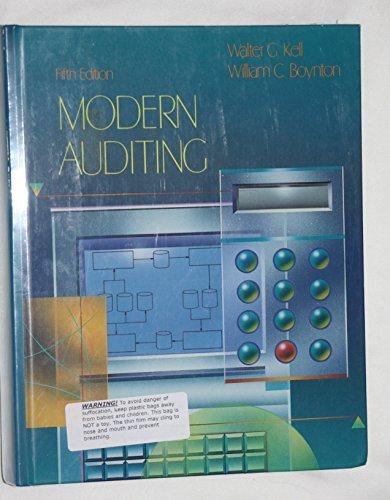The Meyers Pharmaceutical Company, a drug manufacturer, has the following system for billing and recording accounts receivable:
Question:
The Meyers Pharmaceutical Company, a drug manufacturer, has the following system for billing and recording accounts receivable:
1. An incoming customer's purchase order is received in the order department by a clerk who prepares a prenumbered company sales order form in which is inserted the pertinent information, such as the customer's name and address, customer's account number, quantity and items ordered. After the sales order form has been prepared, the customer's purchase order is stapled to it.
2. The sales order form is then passed to the credit department for credit approval. Rough approximations of the biling values of the orders are made in the credit department for those accounts on which credit limitations are imposed. After investigation, approval of credit is noted on the form.
3. Next the sales order form is passed to the billing department where a clerk types the customer's invoice on a billing machine that crossmultiplies the number of items and the unit price, then adds the automatically extended amounts for the total amount of the invoice. The billing clerk determines the unit prices for the items from a list of billing prices.
The billing machine has registers that automatically accumulate daily totals of customer account numbers and invoice amounts to provide "hash" totals and control amounts. These totals, which are inserted in a daily record book, serve as predetermined batch totals for verification of computer inputs.
The billing is done on prenumbered, continuous, carbon-interleaved forms having the following designations:
a. "Customer's copy."
b. "Sales department copy," for information purposes.
c. "File copy."
d. "Shipping department copy," which serves as a shipping order. Bills of lading are also prepared as carbon copy by-products of the invoicing procedure.
4. The shipping department copy of the invoice and the bills of lading are then sesnt to the shipping department. After the order has been shipped, copies of the bill of lading are returned to the billing department. The shipping department copy of the invoice is filed in the shipping department.
5. In the billing department, one copy of the bill of lading is attached to the customer's copy of the invoice and both are mailed to the customer. The other copy of the bill of lading, together with the sales order form, is then stapled to the invoice file copy and filed in invoice numerical order.
6. A keypunch machine is connected to the billing machine so that punched cards are created during the preparation of the invoices. The punched cards then become the means by which the sales data are transmitted to a computer.
The punched cards are fed to the computer in batches. One day's accumulation of cards comprises a batch. After the punched cards have been processed by the computer, they are placed in files and held for about two years.
Required:
List the procedures that a CPA would employ in his examination of his selected audit samples of the company's (1) typed invoices, including the source documents, and (2) punched cards. (The listed procedures should be limited to the verification of the sales data being fed into the computer. Do not carry the procedures beyond the point at which the cards are ready to be fed to the computer.)
Step by Step Answer:

Modern Auditing
ISBN: 9780471542834
5th Edition
Authors: Walter Gerry Kell, William C. Boynton, Richard E. Ziegler





